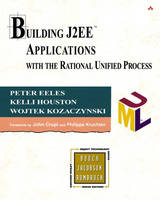
Building J2EE™ Applications with the Rational Unified Process
Addison Wesley (Verlag)
978-0-201-79166-2 (ISBN)
- Titel ist leider vergriffen;
keine Neuauflage - Artikel merken
This book is a Rational Software Corporation-specific book focusing on the development of J2EE applications (version 1.3) within a RUP (Rational Unified Process) environment. As such, the book has a heavy dependency on UML (version 1.4). The authors aim to give the reader a basic understanding of component architectures and associated technologies, and how these component architectures and technologies are applied in the context of systematic development, specifically the Rational Unified Process. The reader will learn a set of proven best practices, guidelines, and standards that apply to systems development. It will reflect the next version of RUP which is scheduled for release during in 2002. This version of RUP will be a considerable departure from the current version.
Peter Eeles works at Rational Software. He is a Senior Technical Consultant in Rational's Strategic Services Organization and assists organizations in their adoption of the Rational Unified Process and the Rational toolset in architecture-centric initiatives. He is coauthor of Building Business Objects (John Wiley & Sons, 1998) and a contributing author to Software Architectures (Springer-Verlag, 1999). Kelli Houston works at Rational Software. She is a Senior Architecture Consultant developing solution packages for accelerating J2EE and .NET development. She is a contributing author to Component-Based Software Engineering (Addison-Wesley, 2001). Wojtek Kozaczynski works at Rational Software. He is the Director of Architecture and Application Frameworks. He develops tools and processes for the development of architecture frameworks and reusable software assets. He is also a contributing author to Component-Based Software Engineering (Addison-Wesley, 2001). 0201791668AB07242002
(NOTE: Chapters 2-9 conclude with a Summary.)
Foreword by Philippe Kruchten.
Foreword by John Croupi.
Preface.
1. Introduction.
How this Book is Organized.
2. An Introduction to the Java 2(TM) Platform, Enterprise Edition.
Enterprise Concerns.
Business Concerns.
Integration Concerns.
Development Concerns.
Multi-Tier Architectures and the J2EE Platform.
J2EE Platform Overview.
J2EE Technology Overview.
Containers.
Presentation Tier.
Business Tier.
Integration Tier.
J2EE Deployment Configurations.
J2EE Component Technologies.
Applets.
Application Clients.
Java Servlets.
JavaServer Pages (JSP).
Enterprise JavaBeans (EJB).
Assembly and Deployment.
J2EE Modules.
3. An Introduction to the Rational Unified Process.
Best Practices — The Foundation of RUP.
RUP Key Concepts.
Artifacts.
Roles.
Activities.
Disciplines.
Workflow Details.
Iterations.
Phases.
RUP as a Process Framework.
4. An Introduction to the J2EE Developer Roadmap.
What is a RUP Roadmap?
J2EE Developer Roadmap — Scope and Rationale.
J2EE Developer Roadmap — J2EE-Specific Content.
5. An Introduction to the Sample Application.
Application Overview.
Problem Statement.
Stakeholders and Users.
Stakeholders, Their Concerns and Responsibilities.
Users, Their Concerns and Responsibilities.
Functional Features and Constraints.
Other Requirements and Properties.
Non-Functional Properties.
User Environment.
Deployment Environment.
6. Requirements.
Requirements and Iterative Development.
Requirements Overview.
Workflow Detail: Define the System.
Activity: Capture a Common Vocabulary.
Activity: Find Actors and Use Cases.
Activity: Prioritize Use Cases.
Activity: Review the Requirements.
Workflow Detail: Refine the System Definition.
Activity: Detail a Use Case.
Activity: Structure the Use-Case Model.
Activity: Review the Requirements.
7. Analysis.
Analysis and Iterative Development.
Analysis Overview.
Workflow Detail: Define an Initial Architecture.
Activity: Architectural Analysis.
Activity: Review the Initial Architecture.
Workflow Detail: Analyze Behavior.
Activity: Model the User Experience.
Activity: Review the User Experience.
Activity: Use-Case Analysis.
Activity: Review the Analysis.
8. Design.
Design and Iterative Development.
Design Overview.
Workflow Detail: Refine the Architecture.
Activity: Identify Design Mechanisms.
Activity: Identify Design Elements.
Activity: Incorporate Existing Design Elements.
Activity: Describe Distribution and Concurrency.
Activity: Review the Architecture.
Workflow Detail: Detail the Design.
Activity: Use-Case Design.
Activity: Subsystem Design.
Activity: Component Design.
Activity: Class Design.
Activity: Database Design.
Activity: Review the Design.
9. Implementation.
Implementation and Iterative Development.
Implementation Overview.
Workflow Detail: Structure the Implementation Model.
Activity: Structure the Implementation Model.
Activity: Review the Implementation.
Workflow Detail: Implement Design Elements.
Activity: Implement Design Elements.
Activity: Perform Unit Tests.
Activity: Review the Implementation.
10. Additional Topics.
Business Modeling.
Testing.
Deployment.
Configuration and Change Management.
Project Management.
Environment.
Other Considerations.
In Conclusion — A Note from the Authors.
Appendix A: Describing a Software Architecture.
Introduction.
What Is Architecture?
Communicating the Architecture of a System.
The Software Architecture Document.
Appendix B: Modeling Conventions.
UML Representation of J2EE Developer.
Roadmap Elements.
Requirements Artifacts.
Analysis Artifacts.
Design Artifacts.
Implementation Artifacts.
Design Relationships.
Design Class Attributes and Operations.
J2EE Developer Roadmap Model Structure Guidelines.
Use-Case Model.
User-Experience Model.
Design Model.
Implementation ModeL.
Appendix C — Glossary.
Terms.
Acronyms.
Index. 0201791668T05172002
| Erscheint lt. Verlag | 2.9.2002 |
|---|---|
| Verlagsort | Boston |
| Sprache | englisch |
| Maße | 187 x 235 mm |
| Gewicht | 450 g |
| Themenwelt | Mathematik / Informatik ► Informatik ► Netzwerke |
| Informatik ► Programmiersprachen / -werkzeuge ► Java | |
| Informatik ► Software Entwicklung ► Objektorientierung | |
| Informatik ► Software Entwicklung ► UML | |
| Mathematik / Informatik ► Informatik ► Web / Internet | |
| ISBN-10 | 0-201-79166-8 / 0201791668 |
| ISBN-13 | 978-0-201-79166-2 / 9780201791662 |
| Zustand | Neuware |
| Informationen gemäß Produktsicherheitsverordnung (GPSR) | |
| Haben Sie eine Frage zum Produkt? |
aus dem Bereich


